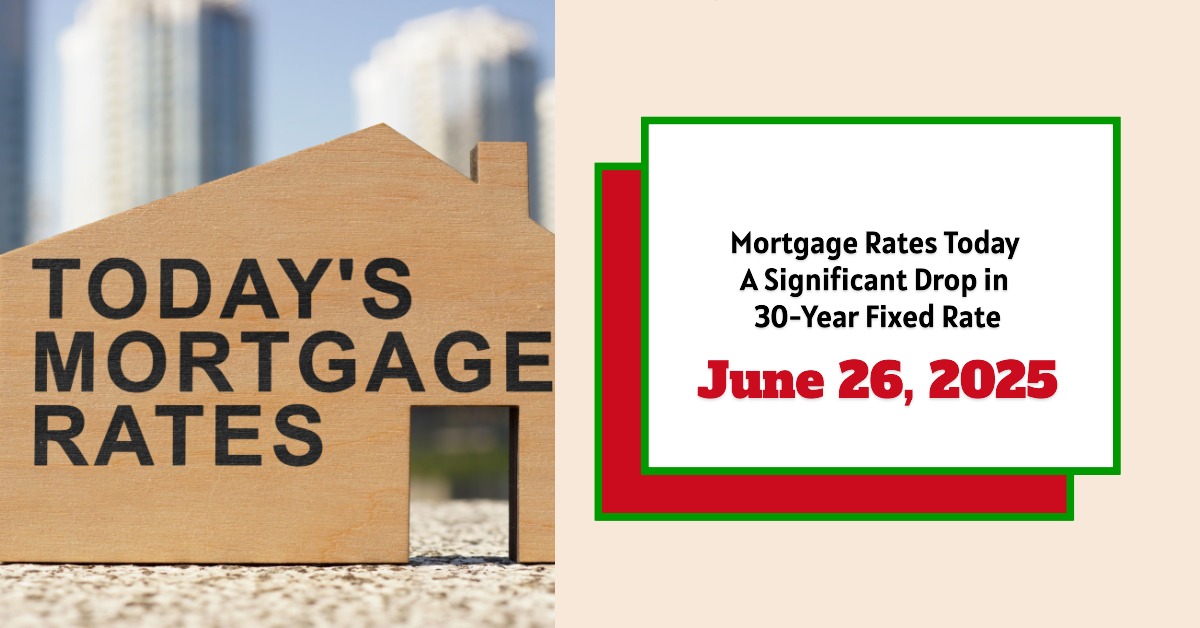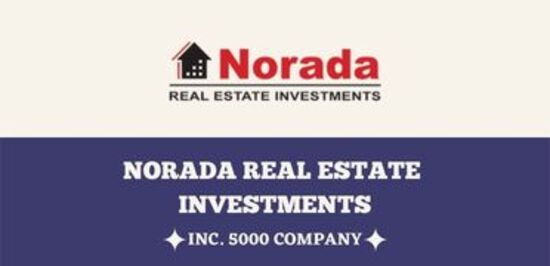Today's average 30-year fixed mortgage rate has seen a notable decrease, dropping to 6.81% from 6.82%, which marks a decline of 1 basis point from the previous day. More importantly, this rate has reduced by 10 basis points from last week’s average of 6.91%. This change presents an exciting opportunity for potential homebuyers and those looking to refinance their mortgages.
Mortgage Rates Today June 26, 2025: A Significant Drop in 30-Year Fixed Rate
Key Takeaways
- 30-Year Fixed Rate: Currently at 6.81%, down from 6.91% last week.
- 15-Year Fixed Rate: Decreased slightly to 5.85%.
- Current Refinance Rate: 30-year fixed refinance rates fell to 7.03%.
- Economic Influences: Inflation, investor sentiment, and Federal Reserve policies heavily influence mortgage rates.
Understanding today's mortgage rates is crucial for borrowers, especially given the current state of the economy and housing market.
Current Mortgage and Refinance Rates Overview
To better understand the trends, here’s a snapshot of the current mortgage rates as of June 26, 2025:
| Mortgage Type | Current Rate | 1 Week Change | APR | 1 Week Change |
|---|---|---|---|---|
| 30-Year Fixed Rate | 6.81% | Down 0.11% | 7.22% | Down 0.15% |
| 15-Year Fixed Rate | 5.85% | Down 0.12% | 6.12% | Down 0.15% |
| 20-Year Fixed Rate | 6.65% | Up 0.07% | 6.94% | Down 0.01% |
| 5-Year Adjustable Rate Mortgage | 7.63% | Up 0.43% | 7.92% | Up 0.13% |
| 30-Year FHA Rate | 7.17% | Down 0.16% | 8.20% | Down 0.16% |
| 30-Year VA Rate | 6.27% | Down 0.14% | 6.49% | Down 0.12% |
| 30-Year Jumbo Rate | 7.27% | unchanged | 7.73% | Up 0.06% |
Source: Zillow
Economic Factors Influencing Mortgage Rates
Several factors contribute to the current state of mortgage rates. Understanding them can help potential borrowers navigate their decisions.
- Inflation: The Federal Reserve's actions to combat inflation have a direct impact on mortgage rates. By raising interest rates, the Fed aims to control economic growth and stabilizes prices. This approach can increase mortgage rates as lenders adjust to anticipated economic conditions.
- Economic Uncertainty: This term encompasses current crises, ranging from geopolitical tensions to domestic economic challenges. Uncertainty often leads investors to seek safer investments, which can pressure mortgage rates upward.
- Investor Sentiment: The perception of economic stability influences Treasury bond yields. When confidence wanes, investors demand higher yields on bonds, which leads to increased mortgage rates.
- Federal Reserve Policy: Adjustments made by the Federal Reserve in monetary policy play a crucial role. Their decisions regarding interest rates and growth projections can send ripples throughout the lending market.
- Labor Market Conditions: The job market affects borrowing power. A tight labor market may lead to wage increases, prompting more aggressive Federal Reserve actions to control inflation, which could raise mortgage rates.
- Housing Supply and Demand: The balance of housing supply versus demand can also influence rates. If demand for homes continues to outpace supply, it can maintain upward pressure on both home prices and mortgage rates.
- Market Trends: Seasonal factors often influence the housing market. For instance, the spring and summer months commonly see increased buying activity, which can push rates up. Conversely, rates may stabilize or decrease during the winter months when demand typically dips.
Understanding Monthly Payment Calculations
Understanding how the current mortgage rates affect monthly payments can help buyers and homeowners make informed decisions. Let’s explore how the current rates influence monthly payments for different loan amounts:
Monthly Payment on a $300,000 Mortgage
With the current 30-year fixed mortgage rate of 6.81%, a potential borrower will have a monthly payment of approximately $1,943. This estimate includes principal and interest but does not encompass additional costs like property taxes and homeowners insurance, which can significantly affect the total monthly obligation.
Monthly Payment on a $400,000 Mortgage
For a $400,000 mortgage at the same 30-year fixed rate, the monthly payment would be around $2,591. This amount further illustrates how quickly mortgage payments can escalate as loan amounts increase, emphasizing the need for buyers to evaluate their financial situations carefully.
Monthly Payment on a $500,000 Mortgage
If you seek financing for a $500,000 mortgage, your anticipated monthly payments under the current rate would be about $3,239. Understanding this helps borrowers recognize the long-term financial commitment associated with larger loans and the importance of budgeting accordingly.
These amounts account for principal and interest alone, so it is vital to remember that property taxes, homeowners insurance, and potentially private mortgage insurance (PMI) will add to these monthly costs.
Related Topics:
Mortgage Rates Trends as of June 25, 2025
Current Mortgage Refinance Rates
Refinancing is an option many homeowners are considering as rates dip slightly. The current average 30-year fixed refinance rate has dropped to 7.03%, down from 7.08% just a week ago. This represents a key opportunity for homeowners who may want to capitalize on lower annual percentage rates. Here’s how current refinance rates compare:
| Refinance Program | Current Rate | 1 Week Change |
|---|---|---|
| 30-Year Fixed Rate Refinance | 7.03% | Down 0.05% |
| 15-Year Fixed Rate Refinance | 5.95% | Down 0.01% |
| 5-Year Adjustable Rate Refinance | 7.87% | Down 0.01% |
Source: Zillow
Refinancing can serve various purposes: lowering monthly payments, consolidating debt, or tapping into home equity for significant expenses. However, it is essential to consider the costs associated with refinancing, such as closing costs, to assess whether it is a financially sound decision.
Homebuyer Sentiment and Economic Outlook
The economic outlook significantly impacts buyer sentiment, directly correlating to mortgage rates. According to the National Association of REALTORS® Chief Economist Lawrence Yun, there’s reason for cautious optimism regarding the housing market. Yun forecasts a 6% increase in existing home sales for 2025, rebutting the concerns of stagnation during economic downturns. He suggests that even amid economic uncertainty, the demand for housing will persist.
Additionally, Yun predicts an average mortgage rate of 6.4% in the latter part of 2025 and a further dip to 6.1% in 2026. These rates could be considered ideal for buyers looking to enter the housing market soon. A favorable borrowing environment would likely stimulate home purchases and provide relief to prospective investors looking for opportunities within the housing sector.
Broader Market Trends
Several reports suggest slowing but steady improvements in the housing market. The Mortgage Bankers Association expects rates to remain fluctuating in the mid-6% range throughout 2025, settling around 6.7% by year-end. This prediction offers a window for buyers who may want to time their purchases strategically.
In contrast, Freddie Mac anticipates heightened purchase and refinance volumes due to these adjustments, indicating that potential buyers and homeowners' motivations remain strong. With the ongoing volatility in market conditions, it remains critical for buyers to stay informed about future trends and evaluate their options carefully.
Summary:
As we unpack the current mortgage rates on June 26, 2025, we can identify several pivotal shifts within the housing market. The decrease in the 30-year fixed rate provides fresh opportunities for both homebuyers and those considering refinancing existing loans. While rates remain elevated, particularly around 7% in select categories, these emerging trends indicate that market conditions may improve.
With predictions of an upward trend in home sales and potential future declines in mortgage rates, those looking to enter the housing market should remain assertive in their search for ideal loan options. Borrowers must consider all aspects of their financial situations.
Invest Smarter in a High-Rate Environment
With mortgage rates remaining elevated this year, it's more important than ever to focus on cash-flowing investment properties in strong rental markets.
Norada helps investors like you identify turnkey real estate deals that deliver predictable returns—even when borrowing costs are high.
HOT NEW LISTINGS JUST ADDED!
Connect with a Norada investment counselor today (No Obligation):
(800) 611-3060
Also Read:
- Will Mortgage Rates Go Down in 2025: Morgan Stanley's Forecast
- Expect High Mortgage Rates Until 2026: Fannie Mae's 2-Year Forecast
- Mortgage Rate Predictions 2025 from 4 Leading Housing Experts
- Mortgage Rates Forecast for the Next 3 Years: 2025 to 2027
- 30-Year Mortgage Rate Forecast for the Next 5 Years
- 15-Year Mortgage Rate Forecast for the Next 5 Years
- Why Are Mortgage Rates Going Up in 2025: Will Rates Drop?
- Why Are Mortgage Rates So High and Predictions for 2025
- Will Mortgage Rates Ever Be 3% Again in the Future?
- Mortgage Rates Predictions for Next 2 Years
- Mortgage Rate Predictions for Next 5 Years
- Mortgage Rate Predictions: Why 2% and 3% Rates are Out of Reach
- How Lower Mortgage Rates Can Save You Thousands?
- How to Get a Low Mortgage Interest Rate?
- Will Mortgage Rates Ever Be 4% Again?



